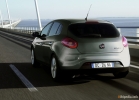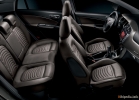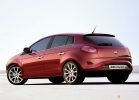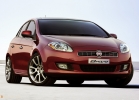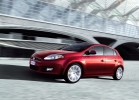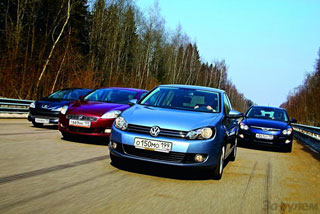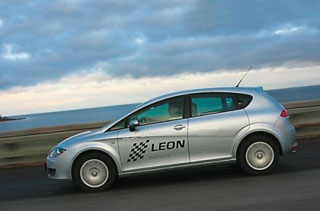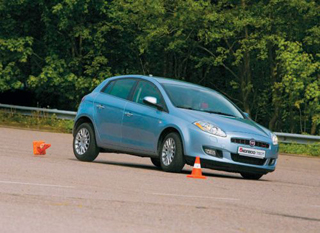Fiat Bravo test drive since 2007 hatchback
Bravo T-Jet Sport
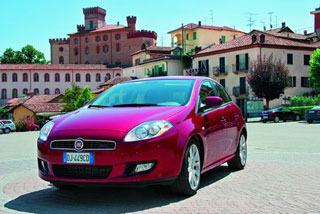 Fiat Bravo. The speaking name of this car for almost a year now in the most unambiguous way has been beaten by the European press. It was the turn of the Russian debut.
Fiat Bravo. The speaking name of this car for almost a year now in the most unambiguous way has been beaten by the European press. It was the turn of the Russian debut. Buildings, like people, can have the most unusual fates. To match the buildings themselves. For example, there is an incredible building in Turin, the 167-meter spire of which, decorated with a spiked mace, ascended over the city with all its palaces and bells. You will never guess what sign I saw above the doors of this eighth miracle of light! Museum of Cinema! Perplexity, however, was allowed very soon: it turned out that the Turin forerunner of the Stalinist skyscrapers was built in 1889 as a local synagogue. No less interesting is the fate of the hotel in which we settled in Turin. At the beginning of the twentieth century, this building was the first FIAT assembly plant, and on its roof a track was located for testing the newly manufactured cars. And now guests can run there with a coward or ride a bicycle. Against this background, the turn of the fate of the former assembly plant, which now houses the Fiat style center, seems much unusual. The new office opened only a couple of weeks ago. Spacious light corridors. Rooms with tall ceilings. The walls are decorated with works of modern painting, increased to the sizes of roadside advertising shields. Opposite the entrance, the violet-yellow Einstein flaunts under his own statement: I am interested in the future because this is the very place in which I intend to finish my days. It sounds somewhat gloomy for automobile design bureaus, but tunes in a high way. And here is the owner of the design director of the style center Christopher Wright.
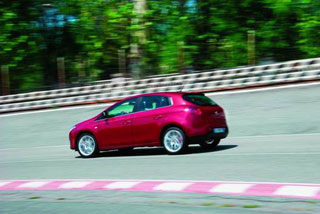 Epohereal car
Epohereal car The European premiere of Bravo took place back in January, and the appearance of this car has not been a secret for a long time. In addition, on this day we already had the opportunity to drive him at a factory test training ground for an hour in a miniature in a miniature with a monstrous profiled turn, which you run on as if on a concrete fence. Nevertheless, the presentation for the Russian market was carried out according to all the rules, with pulling the cover, except that solemn speeches with official jokes invented in the marketing department did not sound. Mr. Recitz immediately spoke that he was closest: Bravo epoch -making car for Fiat. For the first time in the development of the new model, computer technology was so widely used. Thanks to this, we managed to set a world record from the first sketches to launch to production only 18 months. Prior to this, the new models were developed by Toyota. The Japanese spent an average of 26 months on this. The name Bravo is well known to fans fiat. This was the name of the 3-door hatchback, produced from 1995 to 2001 (the 5-door version was called Brava). It was an interesting and successful project. The first -generation Bravo was awarded the title of the car of the year in Europe and even went down in history as the ancestor of the so -called bio -design. Alas, the release of Stilo was replacing him with a crisis that covered the Italian concern. Stilo was created as a German car, but it was by no means in quality or characteristics. He was especially criticized for a boring appearance. And to avoid unpleasant associations when creating the next segment model
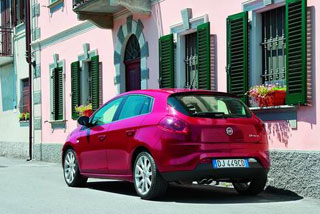 C (compact city cars) in Fiat decided to return to the glorious name. Secondly, Bravo is the ancestor of the new corporate style, the symbol of which is a new logo that first appeared on this model, Mr. Writhz continues to bend his fingers. Take a look at the front. This is what all future Fiat will look like. Let me, and Grande Punto, drawn in the Dzhujaro studio back in 2005? Are these cars not like native brothers? Don't you see differences? The designer is amazed and begins to indicate with the heat of the nuances that, in his eyes, the eyes of the Creator, did not look at all with trifles. Take a look at the headlights! What a complex and expressive form they have in comparison with the pragmatic Grande Punto. Please note that the rear bumper does not protrude for the stern contours. This gives a whole and elegant look of the entire back of the car. The upper part of the radiator is slightly reminiscent of the propeller, and the rear lights are cat eyes. Finally, the bodies of the body themselves are more convex, which emphasizes the sports character of Bravo. See how emotional the design of this model turned out! What a game of light, a game of muscles! We managed to get rid of the facelessness inherent in Fiat cars in the past. Before us is a real Italian car! Interestingly, a real Italian car was created under the leadership of the Austrian who worked in Audi and trained in the secrets of crafts in Japan, in Nissan. Not surprising, Christopher smiles. A person from the side to see something important in the national style is sometimes easier than one who is surrounded by Italy from birth. Looking at the car through the eyes of his creator, admiring all the overflows of his forms and looking at the trifles, it was impossible not to pay attention to the fact that the external beauties were hiding a good build quality, in any case, the gaps between the panels of the body were adjusted evenly and neatly. The third factor, thanks to which Bravo is of particular importance for us, is the quality of manufacture, says Christopher Wrights. In the manufacture of Bravo, we approached the quality standards of Toyota. Everything is calculated from aerodynamics to the flows of the climatic system. This car will be very reliable.
C (compact city cars) in Fiat decided to return to the glorious name. Secondly, Bravo is the ancestor of the new corporate style, the symbol of which is a new logo that first appeared on this model, Mr. Writhz continues to bend his fingers. Take a look at the front. This is what all future Fiat will look like. Let me, and Grande Punto, drawn in the Dzhujaro studio back in 2005? Are these cars not like native brothers? Don't you see differences? The designer is amazed and begins to indicate with the heat of the nuances that, in his eyes, the eyes of the Creator, did not look at all with trifles. Take a look at the headlights! What a complex and expressive form they have in comparison with the pragmatic Grande Punto. Please note that the rear bumper does not protrude for the stern contours. This gives a whole and elegant look of the entire back of the car. The upper part of the radiator is slightly reminiscent of the propeller, and the rear lights are cat eyes. Finally, the bodies of the body themselves are more convex, which emphasizes the sports character of Bravo. See how emotional the design of this model turned out! What a game of light, a game of muscles! We managed to get rid of the facelessness inherent in Fiat cars in the past. Before us is a real Italian car! Interestingly, a real Italian car was created under the leadership of the Austrian who worked in Audi and trained in the secrets of crafts in Japan, in Nissan. Not surprising, Christopher smiles. A person from the side to see something important in the national style is sometimes easier than one who is surrounded by Italy from birth. Looking at the car through the eyes of his creator, admiring all the overflows of his forms and looking at the trifles, it was impossible not to pay attention to the fact that the external beauties were hiding a good build quality, in any case, the gaps between the panels of the body were adjusted evenly and neatly. The third factor, thanks to which Bravo is of particular importance for us, is the quality of manufacture, says Christopher Wrights. In the manufacture of Bravo, we approached the quality standards of Toyota. Everything is calculated from aerodynamics to the flows of the climatic system. This car will be very reliable. 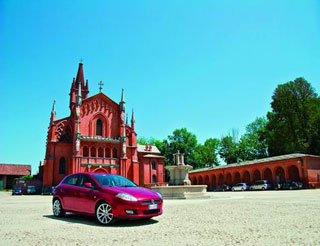 High -quality fiat
High -quality fiat The quality of this car can be seen with the naked eye to sit in the salon. The materials of the finish are worthy of the highest rating. Everywhere you see not cheap shine, but a rich matte reflection. Plastic plastic that imitates the sunk on the central console is especially pleasing to the eye and fingers. Nice for color and to the touch fabric inserts in the doorway. The firmware with a red thread of the skin on the steering wheel and hand brake levers and gearboxes looks good (for the test we got a car in the richest configuration of Sport). Honestly, the seat did not seem exhaustively comfortable in the sense of supporting and fixing the body, but the presence of electro -regulations in all conceivable areas, coupled with both height and removal, allows you to find a convenient pose for a person of any complexion. The salon is quite spacious both in front and behind. The luggage compartment volume is 400 liters, with folded seats of 1175 liters. The quality of the chassis is primarily manifested in the stability that distinguishes Bravo on the highway. Up to speeds at 200 km/h, the car goes smoothly, restructuring during overtaking is not accompanied by any surprises. At the same time, the suspension does not at all suffer from excessive stiffness. The car coped with the flaws of the canvas quite successfully. Bravo is based on the same Fiat platform C, on which Stilo was built, but it was processed quite thoroughly. The track is expanded by 20 mm, the geometry under the wheels of a larger diameter has been changed, and more rigid reptile stabilizers are used both in front and behind, the rigidity was changed
 springs and shock absorbers. The chassis and body have become tougher and stronger. In front, a suspension of the Mcphereson type, a semi -dependent with a torsion beam is used in front. This is a less exquisite solution than an independent multi -link on the rear axes of Golf and Focus, however, in those modes in which these cars are operated, you can hardly feel a great difference. I was pleased with acoustic comfort. In any case, the noise of the road and the air flow are cut off perfectly. Only the engine roller no, no, no, and broke through, because we had a top version with a 150-horsepower T-jet family. Perhaps it is he who is the main highlight of the novelty. Bravo is equipped with three gasoline engines (we still keep silent about diesel modifications, in Russia they appear, then not at the first stage of sales). An interesting approach: they are all the same and relatively small volume of 1.4 liters. Atmospheric engine develops a power of 90 hp, and two turbocharged 120 and 150 hp. A modest working volume allows you to quite effectively fight turbopaus: a delay in the reaction to pressing the gas pedal, if you feel, then only at the lowest revolutions. And yet, at first it seemed that even with this engine the new Fiat (like many models of this company in the past) did not have enough spark, a chopper: a steering system with an electric power, the degree of amplification of which depends on speed, too supple, the brakes are understandable, but again They were too unloaded by the amplifier, even the engine reviews to press the gas pedal seemed to be fast, but rather restrained for a 150-horsepower turbo engine. His power was more likely to affect the flexibility of the transmission: at almost any speed you can go in any gear,
springs and shock absorbers. The chassis and body have become tougher and stronger. In front, a suspension of the Mcphereson type, a semi -dependent with a torsion beam is used in front. This is a less exquisite solution than an independent multi -link on the rear axes of Golf and Focus, however, in those modes in which these cars are operated, you can hardly feel a great difference. I was pleased with acoustic comfort. In any case, the noise of the road and the air flow are cut off perfectly. Only the engine roller no, no, no, and broke through, because we had a top version with a 150-horsepower T-jet family. Perhaps it is he who is the main highlight of the novelty. Bravo is equipped with three gasoline engines (we still keep silent about diesel modifications, in Russia they appear, then not at the first stage of sales). An interesting approach: they are all the same and relatively small volume of 1.4 liters. Atmospheric engine develops a power of 90 hp, and two turbocharged 120 and 150 hp. A modest working volume allows you to quite effectively fight turbopaus: a delay in the reaction to pressing the gas pedal, if you feel, then only at the lowest revolutions. And yet, at first it seemed that even with this engine the new Fiat (like many models of this company in the past) did not have enough spark, a chopper: a steering system with an electric power, the degree of amplification of which depends on speed, too supple, the brakes are understandable, but again They were too unloaded by the amplifier, even the engine reviews to press the gas pedal seemed to be fast, but rather restrained for a 150-horsepower turbo engine. His power was more likely to affect the flexibility of the transmission: at almost any speed you can go in any gear, 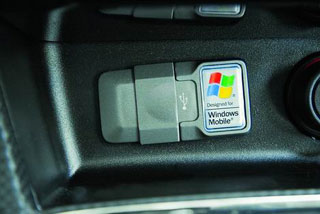 accelerated decently. The need for a frequent appeal to the lever of a mechanical 6-speed box does not arise. (The gasoline versions are equipped only with mechanics, the robotic gearbox will appear next year.) In general, it is clear that the creators had no intention of turning the turbine into a vacuum cleaner for money. Savings and ecology is one of the main priorities for a city car. Fuel consumption 7.1 liters per 100 km impressive achievement for the turbo engine. The block of such a small working volume as the basis of the T-Jet engines family was chosen, among other things, for reasons of saving fuel. However, it turned out that the designers did not forget about the lovers of the sharp. A slight feeling of dissatisfaction with the dynamics passed immediately after a huge, but until a certain moment hidden from my inquisitive gaze, the Sport button was discovered on the central console. This button turns on the fast and the thrust rises from 206 to 230 nm, and the reactions to pressing the electronic pedal of the gas become more acute (at least subjectively). After the small letter S on the on -board computer display, the Bravo behavior became, one might say, provocative. In a leisurely flow of transport, it was all the time to put it out as it should. Not just brave! Bravissimo!
accelerated decently. The need for a frequent appeal to the lever of a mechanical 6-speed box does not arise. (The gasoline versions are equipped only with mechanics, the robotic gearbox will appear next year.) In general, it is clear that the creators had no intention of turning the turbine into a vacuum cleaner for money. Savings and ecology is one of the main priorities for a city car. Fuel consumption 7.1 liters per 100 km impressive achievement for the turbo engine. The block of such a small working volume as the basis of the T-Jet engines family was chosen, among other things, for reasons of saving fuel. However, it turned out that the designers did not forget about the lovers of the sharp. A slight feeling of dissatisfaction with the dynamics passed immediately after a huge, but until a certain moment hidden from my inquisitive gaze, the Sport button was discovered on the central console. This button turns on the fast and the thrust rises from 206 to 230 nm, and the reactions to pressing the electronic pedal of the gas become more acute (at least subjectively). After the small letter S on the on -board computer display, the Bravo behavior became, one might say, provocative. In a leisurely flow of transport, it was all the time to put it out as it should. Not just brave! Bravissimo! European
Bravo one hundred percent European. It will be produced at the Fiat plant in Central Italy. It is intended for Europe, for those motorists who want to have everything in their compact city car that is available to owners of cars higher and in the sense of equipment, and in terms of running qualities. Bravo buyer can order an automatic two-zone climatic system, panoramic roof, 6.5-inch color monitor, cruise control, parking sensor, rain sensor, tire pressure sensor, as well as unusual options as the new generation of the Blue & Me system developed in cooperation with Microsoft. From now on, it is connected to the navigation system and is called Blue & Me Nav. In addition to the previous possibilities (a wireless phone connection, downloading music through a USB input, working with SMS messages) now this system is combined with satellite navigation, and the cards for it are not entered with CDs, but through a USB port. The elite character of Fiat Bravo is emphasized even by the size of the wheels of the largest 16 inches. The qualities of this car are not limited only to external bravado.
Some technical characteristics Fiat Bravo T-Jet Sport
Dimensions, mm 4336x1792x1498
Equipped mass, kg 1275
Type of engine gasoline L4 turbocharged
Working volume, cubic meter. cm 1368
Max. Power, L.S./rpm 150/5500
Max. moment, Nm/rpm 206/2250 (230/3000)
Mechanical transmission 6-speed
Front drive
Max. Speed, km/h 212
Acceleration time 0100 km/h, from 8.5 (8.2)
Fuel consumption (EU), l/100 km 7.1
Leonid Sitnik
Photo by the author
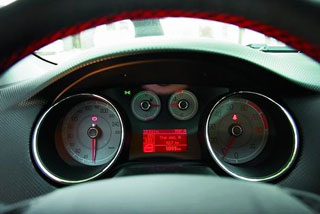
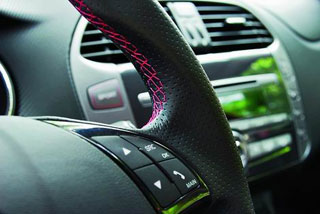
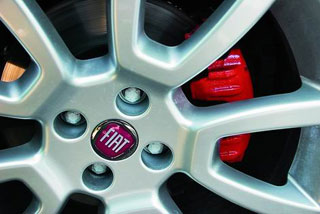

Source: Avtopanorama magazine
Video Test Drive Fiat Bravo since 2007
Video Crash tests Fiat Bravo since 2007
Fiat Bravo test drives since 2007
Crash Test Fiat Bravo since 2007
Krassh Test: Detailed Information33%
Driver and passengers
16%
Pedestrians
36%
Children-passengers

